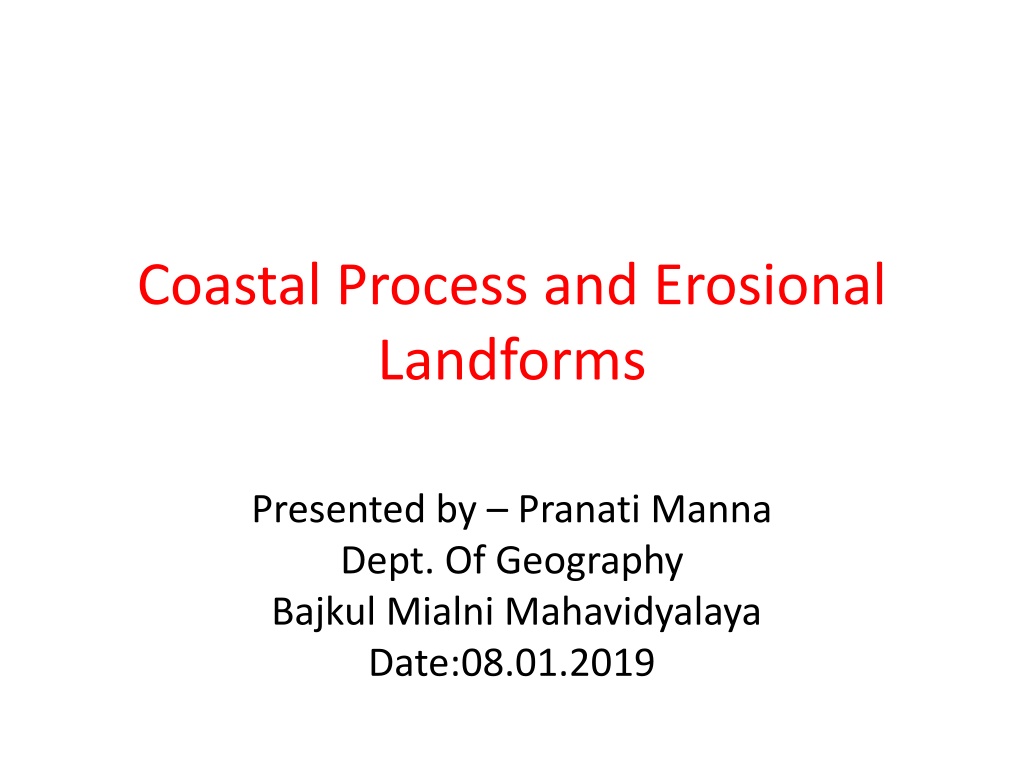
Understanding Coastal Processes and Erosional Landforms
This presentation delves into the mechanisms of coastal erosion driven by sea water, waves, and tsunamis, highlighting the role of processes like attrition, hydraulic action, corrosion, and abrasion. It also explores iconic coastal landforms such as headlands, bays, cliffs, wave-cut platforms, caves, arches, stacks, and stumps.
Download Presentation

Please find below an Image/Link to download the presentation.
The content on the website is provided AS IS for your information and personal use only. It may not be sold, licensed, or shared on other websites without obtaining consent from the author. Download presentation by click this link. If you encounter any issues during the download, it is possible that the publisher has removed the file from their server.
E N D
Presentation Transcript
Coastal Process and Erosional Landforms Presented by Pranati Manna Dept. Of Geography Bajkul Mialni Mahavidyalaya Date:08.01.2019
INTRODUCTION The Action Of Sea Water sea waves and tsunamis are the most powerful agents of marine erosion. Currents are relatively less impactful means of erosion but are important means of transportation . Tides are mainly agents of deposition. Formation Of Sea Waves Sea waves are undulations of sea water. The waves are caused by friction between the water and the blowing wind. As the wind blows , it transfers its energy through friction causing the water to move in a circular motion . As the wave nears the shore , the friction of these circular waves with the seafloor causes the wave base to slow down . The top of the wave curves over until the wave crashes and breaks on the shore . Finally , the water recedes into the sea
Processes of erosion Attrition Materials carried by the waves bump into each other and so are smoothed and broken down into smaller particles. Hydraulic action This process involves the force of water against the coast. The waves enter cracks (faults) in the coastline and compress the air within the crack. When the wave retreats, the air in the crack expands quickly, causing a minor explosion. This process is repeated continuously. Corrosion This is the chemical action of sea water. The acids in the salt water slowly dissolve rocks on the coast. Limestone and chalk are particularly prone to this process. Abrasion/Corrasion This is the process by which the coast is worn down by material carried by the waves. Waves throw these particles against the rock, sometimes at high velocity.
Landforms of coastal erosion 1) Headlands and Bays 2) Cliffs and Wave Cut Platforms 3) Caves, Arches, Stacks and Stumps
Headland And Bay Headlands and bays are features of coasts that are formed by erosion. Waves wear down different types of rocks at different rates. Softer rocks wear away more quickly than harder rocks . Bays form where the waves erode soft rocks , but headlands are left as land that juts out into the water.
CLIFFS AND WAVE CUT PLATFORM Cliffs are shaped through erosion and weathering . Soft rock erodes quickly and forms gentle sloping cliffs , whereas hard rock is more resistant and forms steep cliffs. A wave cut Platform is a wide gently sloping surface found at the foot of a cliff.
Wave-cut platform The waves attack the base of the cliff through the processes of abrasion, corrosion, hydraulic action and attrition. Over time the cliff will be undercut and a wave-cut notch is formed. Eventually the cliff becomes unstable and collapses. Further cliff retreat will form a wave- cut platform.
Caves , Arches, Stack and Stamp Caves , arches , stacks and stumps are erosional features that are commonly found on a headland . Cracks are formed in the headland through the erosional processes of hydraulic action and abrasion. As the waves continue to grind away at the crack it begins to open up to form a cave.
CONCLUSION The result is that the landforms that develop along some coasts are due primarily to wave processes while along other coasts they may be due mainly to tidal processes.
